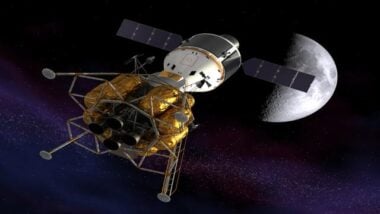Chinese scientists have unveiled ambitious plans to develop a comprehensive communications and navigation network between Earth and the moon.
This infrastructure aims to support The Moon of China The objectives of exploration and improvement of the safety and efficiency of space travel are achieved. The proposed system includes a constellation of satellites and ground stations, providing real-time communication, navigation and monitoring services for lunar missions.
The information highway
Researchers from the China Academy of Space Technology (CAST) The Beijing Institute of Space Engineering and the Beijing Institute of Space Engineering have developed a roadmap to establish an information superhighway between Earth and the Moon. The network would consist of 30 satellites and three lunar ground stations, enabling real-time communication and navigation for up to 20 simultaneous users.
Yang Mengfeichief designer of China’s Chang’e-5 missionhighlighted the strategic importance of this project: “Cislunar space has become a new frontier for human activities. Space activities in this region are expected to grow rapidly over the next decade, leading to a new round of global competition.” The infrastructure would support various space missions by providing precise positioning, navigation and timing (PNT) services, essential for both manned and robotic missions.
The construction of this infrastructure is essential for China in the long term Space Exploration Goals. The network aims to provide comprehensive communications, navigation, and data transmission services, ensuring that lunar missions can be conducted with high accuracy and reliability. The ability to maintain real-time communication and navigation will be crucial to the success of future lunar exploration and potential colonization efforts.

Stages of development
The development of the cislunar infrastructure is planned in three stages, each building on the previous one to create a robust and reliable network:
Initial stage:This step aims to support robotic and manned lunar missions with a pair of satellites in elliptical lunar orbit and a control station on the lunar surface. This initial system will enable communication with the south polar region of the moon for at least 10 users simultaneously. It will lay the foundation for more complex operations and establish the main communication channels required for lunar missions.
Expansion phase:During this phase, 10 satellites will orbit the Moon, Earth, and specific locations called Earth-Moon Lagrange points. A second lunar ground station will be established to improve data transmission rates to 5 gigabytes per second and navigation accuracy to 100 meters for the lunar south pole region. This step aims to expand coverage and improve the network’s performance, making it more capable of meeting diverse mission requirements.
Final step:This stage integrates a comprehensive network of 30 satellites and three lunar ground stations, enabling data transmission rates of 10 gigabytes per second. Navigation accuracy will be improved to 10 meters for lunar surface activities and 50 meters for Earth-Moon travel. A very long baseline interferometry system will track spacecraft over distances of up to 900 million kilometers with sub-kilometer accuracy, supporting deep-space missions to Jupiter and beyond. “Our study has presented a roadmap for assembling such a constellation step by step, extending its coverage from the lunar south pole region to the entire Moon,” said Peng Jing, deputy chief designer of China’s Chang’e-5 mission.
Lunar GPS: High-precision navigation system
In addition to the communications network, Chinese scientists are planning a satellite navigation system around the moon, often called Lunar GPSThis system will provide high-precision location services, improving navigation and positioning accuracy for lunar surface movements, landings and takeoffs.
THE navigation system The project will be developed in three phases and deploy satellites in four types of orbits. The goal is to maintain a sustainable and cost-effective design that ensures reliable coverage and high accuracy. Peng Jing explained the significance of this system: “A constellation of satellites in near-moon space can provide real-time and high-precision navigation and positioning for lunar surface movements, landing and takeoff, and support long-term high-frequency human exploration of the moon.”
This Lunar GPS The system will be crucial to the success of future lunar missions. By providing precise navigation data, it will help ensure safe landings, efficient surface operations, and reliable return voyages. The system’s high-precision services will also be essential for scientific research, resource extraction, and potential colonization activities on the Moon.
International competition and collaboration
The concept of Cislunar space infrastructure The project is gaining traction globally, with the United States, Europe and Japan also proposing similar systems to support their lunar exploration ambitions. The United States Air Force is developing the Cislunar Highway Patrol system to detect, track and identify artificial objects at lunar distances.
China’s initiative aims to establish a competitive advantage in the emerging cislunar economy and support the nation’s aspirations as a space power. The proposed infrastructure aims to avoid repetitive construction and optimize resource allocation for future missions, including crewed lunar landingsthe construction of an international lunar research station and exploration missions to the outer solar system.
In response to the growing interest in cislunar infrastructureInternational collaboration can also play a crucial role. Sharing technologies, data and best practices could improve the effectiveness and efficiency of lunar exploration efforts. Collaborative projects could lead to more sustainable and mutually beneficial outcomes, fostering a spirit of cooperation in the peaceful use of outer space.
